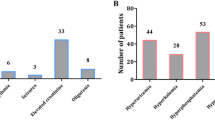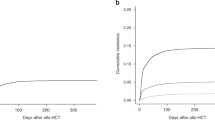Abstract
Patients with multiple myeloma (MM) who undergo autologous stem cell transplantation (ASCT) are susceptible to severe infections. Low levels of circulating mannan-binding lectin (MBL) are associated with increased risk of infection. In this prospective study, we evaluated 100 patients who underwent ASCT regarding the effect of MBL on the incidence and severity of febrile episodes. Seventeen patients had MBL levels <500 ng/mL (11 received antibiotic prophylaxis and 6 did not). Although there was no statistical difference regarding the development of febrile episodes between patients with low and normal MBL, among 17 patients with low MBL levels, six out of eleven patients who received antibiotic prophylaxis developed a febrile episode compared with six out of six patients who did not receive antibiotic prophylaxis and developed a febrile episode. Patients with low MBL levels who responded less frequently to first line antibiotic therapy required more frequent administration of a second more advanced line of antibiotics, independently of receiving or not prophylaxis, and required prolonged hospitalization. In the univariate analysis low MBL associated with shorter OS. Our results suggest that patient with low MBL levels should receive antibiotic prophylaxis to reduce the number of febrile episodes and raise the issue of MBL replacement for these patients.
This is a preview of subscription content, access via your institution
Access options
Subscribe to this journal
Receive 12 print issues and online access
$259.00 per year
only $21.58 per issue
Buy this article
- Purchase on Springer Link
- Instant access to full article PDF
Prices may be subject to local taxes which are calculated during checkout



Similar content being viewed by others
References
Costa Daniel B. et al. Recurrent infections in multiple myeloma. Mayo Clin Proc 2006; 81: 566–569.
Costa DB, Shin B, Cooper DL . Pneumococcemia as the presenting feature of multiple myeloma. Am J Hematol 2004; 77: 277–281.
MacGregor RR, Negendank WG, Schreiber AD . Impaired granulokine adherence in multiple myeloma: relationship to complement system, granulocyte delivery and infection. Blood 1978; 51: 591–599.
Hargreaves RM, Lea JR, Griffiths H, Faux JA, Holt JM, Reid C et al. Immunological factors and risk of infection in plateau phase myeloma. J Clin Pathol 1995; 48: 260–266.
Auner HW, Sill H, Mulabecirovic A, Linkesch W, Krause R . Infectious complications after autologous hematopoietic stem cell transplantation: comparison of patients with acute myeloid leukemia, malignant lymphoma, and multiple myeloma. Ann Hematol 2002; 81: 374–377.
Wallis R . Interactions between mannose-binding lectin and MASPs during complement activation by the lectin pathway. Immunobiology 2007; 212: 289–299.
Litzman J, Freiberger T, Grimbacher B, Gathmann B, Salzer U, Pavlík T et al. Mannose-binding lectin gene polymorphic variants predispose to the development of bronchopulmonary complications but have no influence on other clinical and laboratory symptoms or signs of common variable immunodeficiency. Clin Exp Immunol 2008; 153: 324–330.
Cedzynski M, Szemraj J, Swierzko AS, Bak-Romaniszyn L, Banasik M, Zeman K et al. Mannan-binding lectin insufficiency in children with recurrent infections of the respiratory system. Clin Exp Immunol 2004; 136: 304–311.
Frakking FN, Brouwer N, van Eijkelenburg NK, Merkus MP, Kuijpers TW, Offringa M et al. Low mannose-binding lectin (MBL) levels in neonates with pneumonia and sepsis. Clin Exp Immunol 2007; 150: 255–262.
Fraking FN, van de Wetering MD, Brouwer N, Dolman KM, Geissler J, Lemkes B et al. The role of mannose-binding lectin (MBL) in paediatric oncology patients with febrile neutropenia. Eur J Cancer 2006; 42: 909–916.
Townsend R, Read RC, Turner MW, Klein NJ, Jack DL . Differential recognition of obligate anaerobic bacteria by human mannose-binding lectin. Clin Exp Immunol 2001; 124: 223–228.
Turner MW . Mannose-binding lectin (MBL) in health and disease. Immunobiology 1998; 199: 327–339.
Takahashi K, Shi L, Gowda LD, Ezekowitz RA . Relative roles of complement factor 3 and mannose-binding lectin in host defense against infection. Infect Immunity 2005; 73: 8188–8193.
Jack DL, Lee ME, Turner MW, Read RC . Mannose-binding lectinenhances phagocytosis and killing of Neisseria meningitis by human macrophages. J Leukoc Biol 2005; 77: 328–336.
Hamvas RM, Johnson M, Vlieger AM, Ling C, Sherriff A, Wade A et al. Role for mannose binding lectin in the prevention of mycoplasma infection. Infect Immunity 2005; 73: 5238–5240.
Ghods FJ, Solgi G, Amirzargar AA, Nikbin B, Ghods AJ . High frequency of clinically significant infections and cytomegalovirus disease in kidney transplant recipients with serum mannose-binding lectin deficiency. Iran J Kidney Dis 2009; 3: 28–33.
Smithson A, Muñoz A, Suarez B, Soto SM, Perello R, Soriano A et al. Association between mannose-binding lectin deficiency and septic shock following acute pyelonephritis due to Escherichia coli. Clin Vaccine Immunol 2007; 14: 256–261.
Augustson BM, Begum G, Dunn JA, Barth NJ, Davies F, Morgan G et al. Early mortality after diagnosis of Multiple Myeloma: analysis of patients entered onto the United Kingdom Medical Research Council Trials between 1980 and 2002–Medical Research Council Adult Leukaemia Working Party. J Clin Oncol 2005; 23: 9219–9226.
Analysis and management of renal failure in fourth MRC myelomatosis trial: MRC working party on leukaemia in adults. Br Med J (Clin Res Ed) 1984; 288: 1411–1416.
McCloskey EV, MacLennan IC, Drayson MT, Chapman C, Dunn J, Kanis JA . A randomized trial of the effect of clodronate on skeletal morbidity in multiple myeloma: MRC working party on leukaemia in adults. Br J Haematol 1998; 100: 317–325.
Nazari S, Ebrahimi M, Abdollah Gorji F, Abadi A, Fahimzad A . Association between serum levels of MASP-2 and neutropenic febrile attacks in children with leukemia. Arch Iran Med 2012; 15: 625–628.
Mullighan CG, Heatley SL, Danner S, Dean MM, Doherty K, Hahn U et al. Mannose-binding lectin status is associated with risk of major infection following myeloablative sibling allogeneic hematopoietic stem cell transplantation. Blood 2008; 112: 2120–2128.
Horiuchi T, Gondo H, Miyagawa H, Otsuka J, Inaba S, Nagafuji K et al. Association of MBL gene polymorphisms with major bacterial infection in patients treated with high-dose chemotherapy and autologous PBSCT. Genes Immunity 2005; 6: 162–166.
Molle I, Steffensen R, Thiel S, Peterslund NA . Chemotherapy-related infections in patients with multiple myeloma: associations with mannan-binding lectin genotypes. Eur J Haematol 2006; 77: 19–26.
Molle I, Peterslund NA, Thiel S, Steffensen R . MBL2 polymorphism and risk of severe infections in multiple myeloma patients receiving high-dose melphalan and autologous stem cell transplantation. Bone Marrow Transpl 2006; 38: 555–560.
Kilpatric DC, McLintock LA, Allan EK, Copland M, Fujita T, Jordanides NE et al. No strong relationship between lectin or plasma ficolins and chemotherapy-related infections. Clin Exp Immunol 2003; 134: 279–284.
Van der Velden WJ, Blijlevens NM, Feuth T, Donnelly JP . Post-transplant events. Febrile mucositis in haematopoietic SCT recipients. Bone Marrow Transpl 2009; 43: 55–60.
Kolbe K, Domkin D, Derigs HG, Bhakdi S, Huber C, Aulitzky WE . Infectious complications during neutropenia subsequent to peripheral blood stem cell transplantation. Bone Marrow Transpl 1997; 19: 143–147.
Eleutherakis-Papaiakovou E, Kostis E, Migkou M, Christoulas D, Terpos E, Gavriatopoulou M et al. Prophylactic antibiotics for the prevention of neutropenic fever in patients undergoing autologous stem-cell transplantation: results of a single institution, randomized phase 2 trial. Am J Hematol 2010; 85: 863–867.
Nosanchuk JD, Sepkowitz KA, Pearse RN, White MH, Nimer SD, Armstrong D . Infectious complications of autologous bone marrow and peripheral stem cell transplantation for refractory leukemia and lymphoma. Bone Marrow Transpl 1996; 18: 355–359.
Kruger W, Rüssmann B, Kröger N, Salomon C, Ekopf N, Elsner HA et al. Early infections in patients undergoing bone marrow or blood stem cell transplantation—A 7 year single centre investigation of 409 cases. Bone Marrow Transpl 1999; 23: 589–597.
Herrman RP, Trent M, Cooney J, Cannell PK . Infections in patients managed at home during autologous stem cell transplantation for lymphoma and multiple myeloma. Bone Marrow Transpl 1999; 24: 1213–1217.
Perez-Simon JA, García-Escobar I, Martinez J, Vazquez L, Caballero D, Cañizo C et al. Antibiotic prophylaxis with meropenem after allogeneic stem cell transplantation. Bone Marrow Transpl 2004; 33: 183–187.
Solano C, Gutierrez A, Martinez F, Gimeno C, Gómez C, Muñoz I et al. Prophylaxis of early bacterial infections after autologous peripheral blood stem cell transplantation (PBSCT): a matched-pair study comparing oral fluoroquinolones and intravenous piperacillin-tazobactam. Bone Marrow Transpl 2005; 36: 59–65.
Slavin MA, Grigg AP, Schwarer AP, Szer J, Spencer A, Sainani A et al. A randomized comparison of empiric or pre-emptive antibiotic therapy after hematopoietic stem cell transplantation. Bone Marrow Transpl 2007; 40: 157–163.
Moller-Kristensen M, Ip WK, Shi L, Gowda LD, Hamblin MR, Thiel S et al. Deficiency of mannose-binding lectin greatly increases susceptibility to postburn infection with Pseudomonas aeruginosa. J Immunol 2006; 176: 1769–1775.
Summerfield JA . Clinical potential of mannose-binding lectin-replacement therapy. Biochem Soc Trans 2003; 31 (Pt 4): 770–773.
Kilpatric DC . Consensus statement on the future of mannan-binding lectin (MBL)-replacement therapy. Biochem Soc Trans 2003; 31 (Pt 4): 776.
Author information
Authors and Affiliations
Corresponding author
Ethics declarations
Competing interests
The authors declare no conflict of interest.
Rights and permissions
About this article
Cite this article
Eleutherakis-Papaiakovou, E., Dimopoulos, MA., Kastritis, E. et al. Low circulating mannan-binding lectin levels correlate with increased frequency and severity of febrile episodes in myeloma patients who undergo ASCT and do not receive antibiotic prophylaxis. Bone Marrow Transplant 52, 1537–1542 (2017). https://doi.org/10.1038/bmt.2017.172
Received:
Revised:
Accepted:
Published:
Issue Date:
DOI: https://doi.org/10.1038/bmt.2017.172



